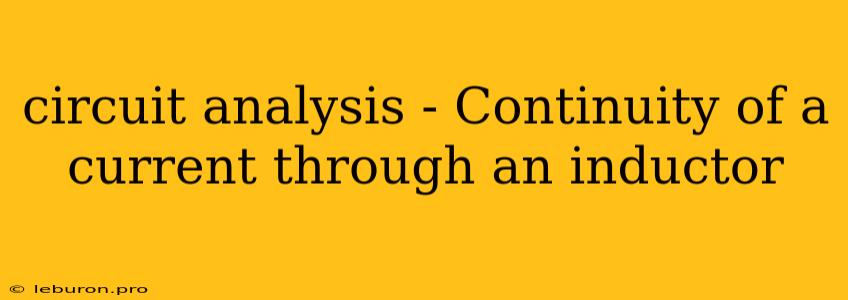Understanding the Continuity of Current Through an Inductor: A Comprehensive Guide
Inductors, fundamental components in electronic circuits, possess a unique property that sets them apart from resistors and capacitors: the continuity of current. This intriguing characteristic arises from the inductor's inherent ability to store energy in the form of a magnetic field. Understanding this concept is crucial for analyzing and designing circuits involving inductors, as it plays a pivotal role in their behavior and interaction with other circuit elements. This article delves into the concept of current continuity through an inductor, exploring its implications and providing practical examples for a deeper understanding.
The Nature of Inductors
Before delving into the continuity of current, let's establish a firm grasp of what inductors are and how they function. An inductor is essentially a coil of wire that generates a magnetic field when current flows through it. The strength of this magnetic field is directly proportional to the amount of current passing through the coil. The key property that governs an inductor's behavior is its inductance, measured in Henries (H), which represents the coil's ability to store energy in its magnetic field.
The Concept of Current Continuity
The principle of current continuity through an inductor states that the current flowing through an inductor cannot change instantaneously. This fundamental behavior stems from the inductor's ability to store energy in its magnetic field. When the current flowing through an inductor changes, the magnetic field surrounding the inductor also changes, either strengthening or weakening. This change in the magnetic field induces an electromotive force (EMF) across the inductor, which opposes the change in current.
How Continuity Affects Circuit Analysis
The concept of current continuity through an inductor has profound implications for circuit analysis. When dealing with circuits containing inductors, it's essential to remember that current cannot change instantaneously. This principle has the following significant implications:
- Inductor Behavior at DC: In a DC circuit, the current through an inductor eventually reaches a steady-state value, and the inductor acts like a short circuit. This is because the inductor's resistance to the flow of DC current is negligible.
- Inductor Behavior at AC: In an AC circuit, the current through an inductor changes continuously, and the inductor opposes the change in current. The inductor's impedance, which is the opposition to the flow of AC current, increases with the frequency of the AC signal.
- Inductor in Series and Parallel Circuits: In series circuits with inductors, the current through each inductor is the same, but the voltage across each inductor can vary. Conversely, in parallel circuits with inductors, the voltage across each inductor is the same, but the current through each inductor can vary.
Practical Examples of Current Continuity
Let's illustrate the concept of current continuity through real-world scenarios:
Scenario 1: Opening a Switch in an Inductive Circuit
Imagine a circuit with an inductor connected in series with a switch. When the switch is closed, current flows through the inductor, establishing a magnetic field. Now, if we suddenly open the switch, we expect the current to stop instantaneously. However, the inductor's magnetic field opposes this change, inducing a high voltage across the inductor. This high voltage can be sufficient to cause arcing across the switch contacts, potentially damaging the circuit or components.
Scenario 2: Charging and Discharging a Capacitor through an Inductor
Consider a circuit with a capacitor connected in parallel with an inductor. When the capacitor is charged and then connected to the inductor, the current starts flowing through the inductor, building up a magnetic field. This magnetic field stores energy. As the current increases, the capacitor starts to discharge, releasing energy into the magnetic field. Eventually, the capacitor will be fully discharged, and the current will start to decrease. However, the magnetic field will collapse, inducing an EMF across the inductor, which will cause the capacitor to charge again. This process continues, creating oscillations between the capacitor and inductor.
Conclusion
The continuity of current through an inductor is a fundamental concept that plays a crucial role in understanding the behavior of inductive circuits. Its implications extend to the design of electronic circuits, where inductors are frequently used in filters, transformers, and energy storage applications. By grasping the concept of current continuity, engineers can analyze and predict the behavior of circuits containing inductors, ensuring their efficient and reliable operation. Remember, the inductor's ability to store energy in its magnetic field is the driving force behind its unique property of current continuity, making it a vital component in various electronic applications.
